If you are selling products online, you may have experienced that it can be difficult to get a significant amount of traffic coming from organic results in search engines. Often, the exact same products can be found on hundreds of websites, but only a few sites can rank at or near the top of the SERP’s where most clicks are generated. When your rankings are good enough to bring traffic, it feels great! But when, suddenly, the traffic drops, you start wondering if E-commerce SEO really works and why, after things were working well, Google decided that your website should no longer be an option for a set of search queries.
If you are not familiar with E-commerce SEO yet, take a look at our Guide on this subject: E-commerce SEO Guide [2019]
That’s what brought this client to see us in the first place, claiming that the website was ranking well, bringing a lot of new users to his website, but in the middle of June 2019, the organic traffic significantly decreased.
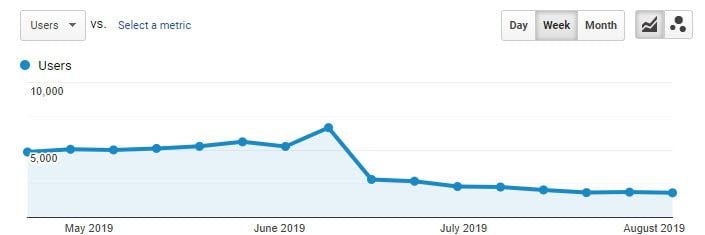
We came on board between 4 and 6 weeks after this incident. Our preliminary conclusion was that the drop was due to a combination of several factors:
Obviously, with so many aspects to deal with, it would be difficult to address everything at once. We decided to deal with the website itself first, leaving the external link issue behind for now, and focused on the following fixes:
The website was indeed very slow, not only for the visitors but also for the administrators. This generally means that either the hosting service does not provide the appropriate server for the amount of traffic and queries and needs to be upgraded, or the website is shooting itself in the foot by using resource-hungry functionality.
As the server seemed to be set up correctly, we have done a lot of work on the website itself in order to improve the loading speed of all pages, especially the home page and all the product-related ones.
The website is built in WordPress, using WooCommerce. This is not an issue on its own, but the website was using a LOT of plugins, some of which were unnecessary and had to be removed or replaced.
In addition, we installed a better caching of the website (great for repeat users) and improved the connection with the database.
Finally, we replaced some Ajax-based resources with Javascript. There is still some work to do in this area.
The way a website is organized will help users and search engines understand better where they are on the site. The original website had a very flat architecture, meaning that most of the pages where direct sub-pages of the home page. It was very difficult to identify which pages were product categories, product pages or blog posts just by looking at their URLs.
All websites, and especially eCommerce sites, should have a thoughtful website structure.
However, making significant changes to the URL structure of a website can be harmful to the site navigation and the rankings in the search engines, so we decided to proceed step-by-step.
We reorganized product categories and product tags. Once cleaned up, we changed the URL structure of those pages only, making sure to redirect their old addresses to the new ones.
After verifying that no errors were triggered by this change, we made sure that all the products would include the primary category they belong to, the main sub-category as needed, and the product name.
Using canonical tags, we made sure that the product pages would refer to one and only one page, removing duplicated content from Google’s index.
Giving the website a clearer hierarchy between the pages gave better clarity to both users and search engines. In addition, removing duplicate content pages from Google’s index should give the website better visibility online. It was now time to focus on one of the most important problems for eCommerce websites: the lack of content.
While those technical changes happened, we had already started working on adding relevant content to the existing pages of the website. In total, to date, we have written text content for 60 pages in 4 months. Most of this content has been provided for the different product categories and sub-categories available on the website.
Inserting content is, however, not enough and we made sure to fully optimize each page from top to bottom, including but not limited to the title, description, heading structure, alt texts, internal linking between the new URLs…
Finally, this was the opportunity for us to make a few additional changes to some other aspects, like de-indexing old pages from Google’s index, and updating and optimizing the XML sitemaps.
As an added bonus, we made the website more user-friendly, introducing a better filtering system to provide an overall better shopping experience.
The results are quite outstanding considering the time frame. Overall, the weekly organic traffic started to climb back up in September and keeps increasing to date. Before the drop, the number of weekly visits was around 5,500 with a peak at 6,500 visits the week just before.
After the drop, the organic traffic went straight down below the 3,000 visits per week and gradually decreased, reaching under the 2,000 weekly visits 6 weeks later, at which point we started working on this website. About 6 weeks later, in September, we started seeing some improvements, with almost 4,000 visitors per week (+100% in six weeks). By the end of October, we passed the 4,000 visitors per week and slowly climbed up to 5,300 visitors in November (+200% in four months), almost entirely recovering from the incident 6 months ago.
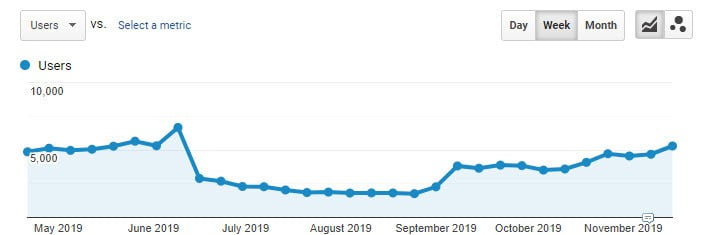
The website is getting faster: even though the improvements do not seem impressive according to Analytics, the average page loading time of all users is on the decreasing trend from 10 seconds at the highest point back in August down to under 6 seconds at the lowest point in November.
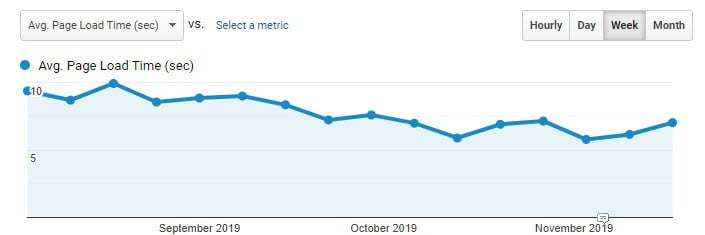
After restructuring the website and cleaning Google’s index, we have noticed significant improvements in terms of website impressions (blue line below): we have been excluding URLs from the index, making sure that only relevant pages were being pushed forward.
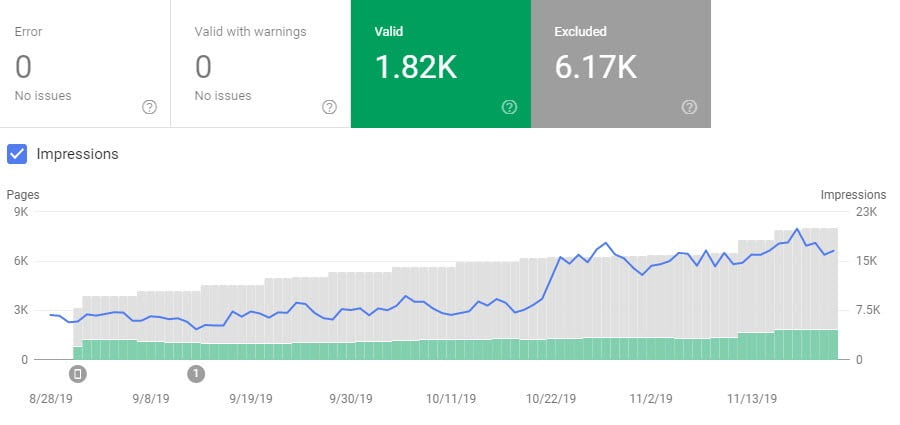
Finally, by providing more relevant content and better user experience, the bounce rate of the website has never been lower.
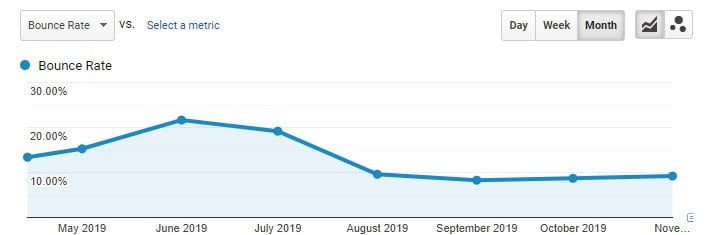
The organic traffic trend and global visibility improvements have been confirmed by the key terms we have been monitoring since August.
The direct consequences of the better rankings was a significant amount of new users and sessions for organic traffic:
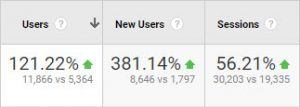
Finally, the extra traffic drove more transactions and revenue:

If you want more details about E-commerce SEO and learn the basics of “How to grow your E-commerce traffic and revenue” take a look at our blog post dedicated to the subject (coming soon). If you would like us to help grow your E-commerce traffic be it from Organic Search, Paid Advertising or Social Media Marketing, contact us!